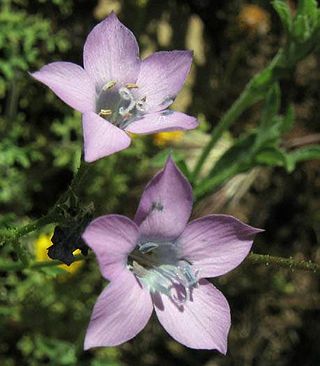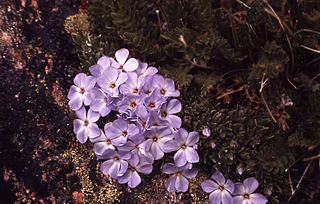
Phlox is a genus of 68 species of perennial and annual plants in the family Polemoniaceae. They are found mostly in North America in diverse habitats from alpine tundra to open woodland and prairie. Some flower in spring, others in summer and fall. Flowers may be pale blue, violet, pink, bright red, or white. Many are fragrant.

Gilia brecciarum is an annual flowering plant in the phlox family (Polemoniaceae), known by the common name Nevada gilia or break gilia.
Gilia minor is a species of flowering plant in the phlox family known by the common name little gilia. It is native to the Mojave Desert and it is also present in the coastal Santa Lucia Mountains of central-southern coastal California.
Gilia ophthalmoides is a species of flowering plant in the phlox family known by the common name eyed gilia. It is native to the Southwestern United States where it can be found in woodlands and high desert plateau.

Saltugilia splendens, is a species of flowering plant in the phlox family known by the common names splendid woodland-gilia, Grinnell's gilia and splendid gilia.

Collomia tracyi is a species of flowering plant in the phlox family known by the common name Tracy's collomia. It is endemic to northern California, where it grows in the coniferous forests of the mountain ranges, including the Klamath Mountains. It is an annual herb producing a slender, branched stem no taller than about 8 centimeters. The glandular, hairy leaves are lance-shaped. The inflorescence is composed of two or three flowers emerging from the leaf axils. Each flower is white to lavender and up to 2 centimeters long. This species can be distinguished from the more common and widespread Collomia tinctoria by the positioning of the stamens and stigma in the flower.
Eriastrum virgatum is a species of flowering plant in the phlox family known by the common name wand woollystar. It is endemic to California, where it is known the coastline and coastal mountain ranges of Monterey and San Benito Counties. It grows in chaparral and coastal and inland scrub habitat. It is an annual herb producing a thin, usually woolly stem up to about 40 centimeters tall. The leaves are narrow and thick, up to 5 centimeters long, and sometimes divided into two narrow lobes. The inflorescence is a woolly cluster of narrow, leaflike bracts laced with webby fibers. The flowers have yellow throats and bright blue corollas with lobes up to a centimeter long.
Leptosiphon nudatus is a species of flowering plant in the phlox family known by the common name Tehachapi linanthus.
Linanthus orcuttii is an uncommon species of flowering plant in the phlox family known by the common name Orcutt's linanthus. It is known only from southern California and Baja California, where it grows in chaparral and pine forests in the Peninsular Ranges and occasionally the San Bernardino Mountains.

Navarretia heterodoxa is a species of flowering plant in the phlox family known by the common name Calistoga pincushionplant. It is endemic to the San Francisco Bay Area in California, where it grows in the serpentine soils of the hills and mountains.

Polemonium californicum is a species of flowering plant in the phlox family known by the common names moving polemonium, low Jacob's-ladder, and California Jacob's ladder. It is native to the northwestern United States, where it grows in shady and moist habitat, such as mountain woodlands. It is a hairy, glandular rhizomatous perennial herb forming clumps of several decumbent to erect stems 30 to 50 centimeters in maximum height. The leaves are up to 20 centimeters long and are compound, made up of several pairs of oval to lance-shaped leaflets. The leaflet at the tip of the leaf is often fused to the pair behind it. The inflorescence is a crowded cluster of bell-shaped flowers each up to 1.5 centimeters wide. The flower is blue or purple with a yellow center and a whitish tubular throat. The fruit is a capsule.
Phacelia austromontana is a species of phacelia known by the common name Southern Sierra phacelia. It is native to the southwestern United States, where it can be found in the Transverse Ranges and Sierra Nevada of California east to Utah. It grows in open mountainous habitat.

Phlox caespitosa is a species of phlox known by the common name tufted phlox. It is native to western North America from British Columbia through the Great Basin to New Mexico, where it grows in scrub, woodland, and other open plateau habitat. It is one of several cushion-forming species that occur in the same region and require careful observation to distinguish. In the past, this species and Phlox douglasii have been erroneously lumped together.

Phlox diffusa is a species of phlox known by the common name spreading phlox. It is native to western North America from British Columbia to the southwestern United States to the Dakotas, where it grows in many types of habitat, including rocky, high elevation mountain slopes. It is a very compact mat-forming perennial herb growing in cushions or patches of short, decumbent stems. The linear, lance-shaped, or needle-like leaves are no more than 1.5 centimeters long and are oppositely arranged in bundles on the short stems. The inflorescence is a solitary tubular flower around a centimeter long. It has a flat white or pale pink or blue corolla with five lobes each just under a centimeter in length.
Phlox dolichantha is a species of phlox known by the common name Big Bear Valley phlox. It is endemic to San Bernardino County, California, where it is limited to the area around Big Bear Lake in the San Bernardino Mountains. It grows in forests and the unique local pebble plain habitat. It occurs at elevations over 2000 meters. It is an erect, branching perennial herb growing up to 30 centimeters tall. The linear or narrowly lance-shaped leaves are 2 to 5 centimeters long and are oppositely arranged on the slender stems. The inflorescence is made up of one or more showy flowers at the tip of the stem. Each flower has a very slender tubular throat up to 5 centimeters long which can be white, pink, or lavender.

Phlox pulvinata is a species of phlox known by the common name cushion phlox. It is native to the western United States where it grows in mountain and plateau habitat, in rocky subalpine and alpine climates, including exposed tundra habitat. It is a perennial herb taking a flat, dense, cushionlike form on the ground. Its very short stems are lined with hair-fringed lance-shaped leaves each no more than one centimeter long. The plant is among the first to flower in the spring in many areas. It blooms densely, forming carpets of flowers. Each white to pale pink flower has a tubular throat up to one centimeter long and a flat five-lobed corolla.

Phlox speciosa is a species of phlox known by the common name showy phlox. It is native to western North America from British Columbia to Arizona and New Mexico, where it occurs in sagebrush, pine woodlands, and mountain forests.

Polemonium chartaceum is a rare species of flowering plant in the phlox family known by the common names Mason's Jacob's-ladder and Mason's sky pilot. It is native to California, where it has a disjunct distribution. It occurs in the Klamath Mountains as well as the ranges east of the Sierra Nevada, including the White Mountains, where its distribution extends just into Nevada. It is a plant of high elevations, growing in exposed, rocky mountain slope habitat such as talus and alpine fellfields.
Physaria fremontii is a species of flowering plant in the family Brassicaceae known by the common name Fremont's bladderpod. It is endemic to Wyoming in the United States, where it occurs only in and around the Wind River Range in Fremont County.
Castilleja kerryana is a species of flowering plant in the family Orobanchaceae. It is commonly known as Kerry's Indian paintbrush or Kerry’spaintbrush. It was formally described in 2013 and so far it is known only from a small population in the state of Montana, in the Northwestern United States.











